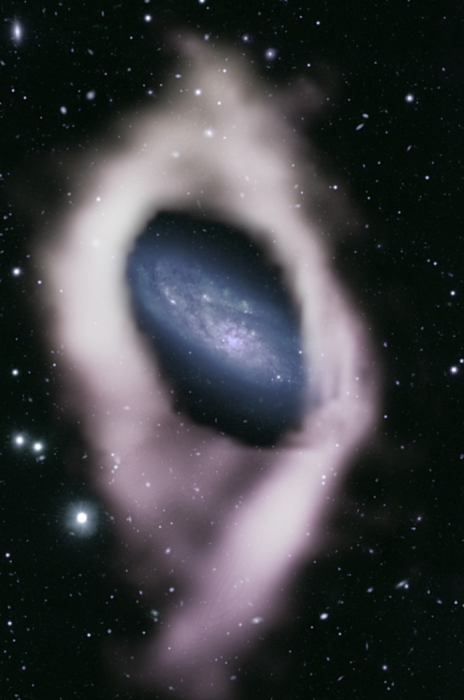A group of international astronomers, including a researcher from the University of Manitoba, have identified two potential polar ring galaxies—a type of galaxy that exhibits a ring of stars and gas perpendicular to its main spiral disk. The results were published in the Monthly Notices of the Royal Astronomical Society .
Researchers Nathan Deg and Kristine Spekkens, in the Physics, Engineering Physics, and Astronomy department at Queen’s University, led the analysis of data. They used the WALLABY survey, an innovative imaging radio telescope owned by CSIRO’s ASKAP (Australian Square Kilometre Array Pathfinder). Looking at sky maps of more than 600 galaxies, they identified two potential polar ring galaxies.

Polar ring galaxies are a type of galaxy that exhibits a ring of stars and gas perpendicular to its main spiral disk.
“Polar ring galaxies are some of the most spectacular looking galaxies in the Universe. These findings suggest that one to three per cent of nearby galaxies may have gaseous polar rings, which is much higher than suggested by optical telescopes,” says researcher Dr. Nathan Deg, who is also the lead author on the study.
Although this is not the first time astronomers have observed polar ring galaxies, they are the first observed using the ASKAP telescope at CSIRO’s Murchison radio astronomy observatory on Wajarri Yamaji Country in Western Australia and virtual reality technology from UCT/IDIA Visualization Laboratory in South Africa. These new detections in gas alone suggest polar ring galaxies might be more common than previously believed.
Visualizing polar ring galaxies
UM’s Dr. Jayanne English, a member of the WALLABY research team, is also an expert in astronomy image-making in the Physics and Astronomy department, and a former postdoctoral fellow researcher at Queen’s. She worked on NASA’s Hubble Heritage Project at the Space Telescope Science Institute. That experience was beneficial on this project as she developed these first images of these gaseous polar ring galaxies using a combination of optical and radio data from the different telescopes in two different locations. Since gaseous polar ring galaxies cannot be seen by the human eye, composite images developed by astronomers create important visualizations using data from different telescopes.
First, optical and infrared data from the Subaru telescope in Hawaii provided the image for the spiral disk of the galaxy. Then, the gaseous ring around it was added based on data obtained from Australia’s CSIRO’s ASKAP radio telescope and its WALLABY survey, covering most of the southern sky, detected atomic hydrogen emission from about half a million galaxies.

“It’s interesting to me because it will provide some evidence how galaxies will change over time” says Jayanne English, expert in astronomy image-making.
English says she was excited to work with such a diverse and collaborative team.
“We were able to work with data that showed a fine grid of velocity channels, which are equivalent to the radio stations on your old-fashioned radio receiver. The richness of the velocity data meant I could assign multiple colours to this composite to subtly convey the motion happening within the polar ring. The dance and choreography of the gas are beautiful, and that motion of the gas gives us some clues as to how galaxies evolve over time.”
The creation of this and other astronomical images are all composites because they include information that our eyes can’t capture. In this particular case, the cold hydrogen gas component, invisible to the human eye, is seen in radio “light” using CSIRO’s ASKAP. English says the subtle colour gradient you see on the ring represents the orbital motions of the gas, with purple-ish tints tracing gas that moves towards the viewer. The emission from the ring was separated from the radio emission emanating from the disk of the galaxy using virtual reality tools, in collaboration with South African Research Chair in Astrophysics and Space Science Astronomy, Tom Jarrett, from the University of Cape Town.
Watch this video to find out how virtual reality was used to discover and explore potential polar ring galaxies.
Understanding how galaxies evolve
Further investigation of polar ring structures can lead to a better understanding of how galaxies evolve. For example, one of the main hypotheses to explain the origin of polar rings is a merger where a larger galaxy ‘swallows’ a smaller one. If polar ring galaxies are more common than previously thought, this could mean that these mergers are more frequent.
“It’s interesting to me because it will provide some evidence how galaxies will change over time” says English.
In the future, polar ring galaxies can also be used to deepen our understanding of the universe, with potential applications in dark matter research. It is possible to use polar rings to probe the shape of the halo region of the host galaxy, which could lead to new clues about the elusive properties of dark matter.
More than 25 global collaborators including researchers from Canada, Australia, South Africa, Ecuador, Burkina Faso, Germany, China, worked together to analyze the data from the first public data release of the WALLABY survey, resulting in the newly published paper.
“I want to congratulate Dr. English on this prestigious accomplishment and important discovery in astrophysics and astronomy,” said Dr. Mario Pinto, Vice President (Research and International). “UM is proud to showcase our research expertise in astrophysics and to be at the forefront of understanding what goes on in deep space.”
The next step for the team is to confirm the polar ring galaxies finding through additional observations using different telescopes, including the MeerKAT radio telescope in South Africa.
Research at the University of Manitoba is partially supported by funding from the Government of Canada Research Support Fund.
https://news.google.com/rss/articles/CBMiSWh0dHBzOi8vbmV3cy51bWFuaXRvYmEuY2EvZGlzY292ZXJ5LW9mLXR3by1wb3RlbnRpYWwtcG9sYXItcmluZy1nYWxheGllcy_SAQA?oc=5
2023-09-13 13:01:23Z
2406913696
Tidak ada komentar:
Posting Komentar